We are reporting now from 68o 08.4’ South and 71o 2.01’ West at the southern end of our sampling transect. It is now 4:30 am and the weather has calmed down for the last 12 hours after almost a day and a half of high seas and 30-35 knot winds. It was hard to sleep last night (I mean yesterday since I sleep during the day and work during the night) because of the 18-feet waves bouncing against the ship and turning our beds into frenetic cradles. Anyway, we were finally able to deploy the megacore after a whole day of only fishing with the Blake trawl.
It has been busy and only between gear deployments can I write a few words about what has been happening in the past few days, and also about some unfortunate events we have had at station G. But, before I start telling you about all the happenings of station G, I must say we are starting to get physically tired. After almost two complete sampling stations and a full adaptation to our 12-hour shift schedules, a few cramped muscles and soar backs are found among our relentless oceanography group. A busy shift doing invertebrate dissections or an almost 12-hour period enclosed inside the freezing aquarium room slicing cores for ATP (to measure sediment microbial biomass and activity) can give the toughest athlete a hard time on the joints and back. But we all get used to it after a while and all we need is some time for stretching.
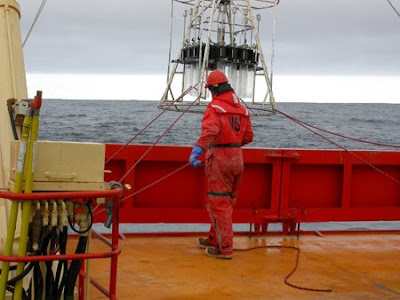
Well, here goes the first setback: we lost our precious box core yesterday! When I woke up two nights ago and went for the midrats (meal served at 11:30 at night) in the galley, the murmur around every table was about the box core and its unfortunate fate. Everyone was shocked and frustrated with the episode since this piece of equipment is important to many of the project’s objectives. The heavy (0.5 ton) box-core did not come back to the surface at all. Jack, the marine tech in the back deck, was a bit surprised not see a box full of mud attached to the wire when it was pulled out of the water through the aft A-frame. People in the E-lab monitoring the computers and the tensiometer noticed pulses of high tension on the wire right after the box-core left the bottom when it was about 1.5 meters off the seafloor. We all suspect that a big rock was the culprit. The box core caught under a big rock when it was pulling out of the sediment causing a lot of tension in the cable and inevitably resulting in the wire breaking. After a few hours of dealing with the loss, the PI’s were already figuring out ways to replace the box core
samples with adapted samples from the megacore. A few incubation experiments will now be conducted using the smaller megacore tubes with a few adaptations that may actually allow them to work. In terms of describing the benthic invertebrate biodiversity of this section of the
Antarctic peninsula, we have probably already collected enough large box core samples from the past two (summer and winter) cruises.

Another drawback was of course the weather that I already mentioned, putting us a little behind of the schedule. But also the bottom camera gave us a hard time insisting on alfunctioning while operating in the yo-yo mode. We spent almost 6 hours with the camera on-deck, ready to deploy, with the electronic technicians working hard to figure out what wasn’t working properly. First it was the bottom contact switch that is supposed to trigger every time the camera is a certain distance away from the sea floor.. Next it was the strobe light that was not firing and then it was the battery inside the camera housing receiving an alternating voltage. Well, we have decided to take a break for now, we still have the epibenthic sled to deploy that may itself represent another challenge and we cannot afford to lose more time since we need to move on to the other stations.


A bright star in the middle of the storm was, at least, the successful recovery of our sediment trap. The trap was deployed during our last summer cruise (Feb 2008) with the aim of collecting sinking particles from the water column that will tell us a lot about seasonal changes in the food-supply for the organisms we are studying in the deep-sea bed of the Antarctic shelf. The trap has a set of 21 jars attached to a large collector funnel that rotates at pre-set time intervals to capture the differences (quantity and quality) in the ‘rain’ of organic particles over time from the surface ocean. The trap was moored about 150 m above the sea bottom and came back to the surface yesterday with help of a line of glass floats and an acoustic release system that dropped the weight holding the trap mooring at the seafloor.



We will be back with news of our next sampling station and I promise I will also tell you what the outcome was for the epibenthic sled sample. It is the first time we are deploying it during this FOODBANCS-2 project. We expect to collect animals that were not previously collected with all the other gear.
See you later…Aloha!










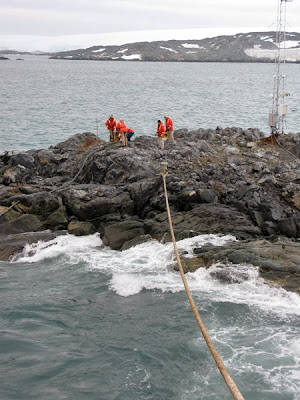






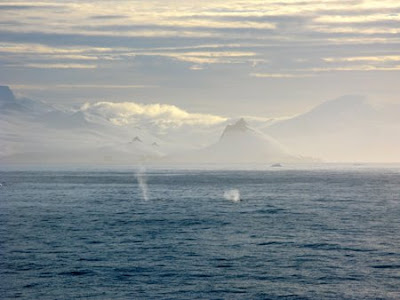
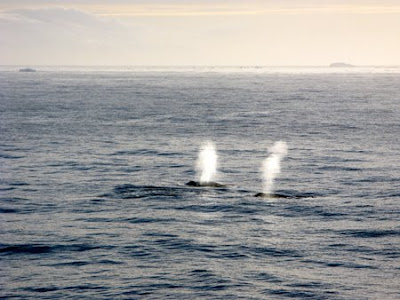













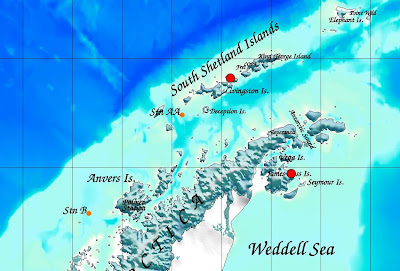
 It is time to leave! We had a meeting at 12:30 pm to set the last details and check if everything we need is onboard. People have been checking the weather forecast all the time because it seems that we are going to have a bad crossing of the Drake Passage. A cruise ship a couple days ago had to cancel its trip to Antarctica because the winds were blowing too hard and they would have gotten into trouble if they had tried to cross the Drake. We saw several disappointed tourists coming down to the harbor exit: so back to Europe is my guess.
It is time to leave! We had a meeting at 12:30 pm to set the last details and check if everything we need is onboard. People have been checking the weather forecast all the time because it seems that we are going to have a bad crossing of the Drake Passage. A cruise ship a couple days ago had to cancel its trip to Antarctica because the winds were blowing too hard and they would have gotten into trouble if they had tried to cross the Drake. We saw several disappointed tourists coming down to the harbor exit: so back to Europe is my guess.







 Pavica, our Croatian team member used the opportunity to send a ingenious postcard to her mom, who is turning 60 today (February 10). Happy birthday Mrs. Srsen !!
Pavica, our Croatian team member used the opportunity to send a ingenious postcard to her mom, who is turning 60 today (February 10). Happy birthday Mrs. Srsen !!


 Melissa
Melissa Rhian
Rhian Fabio
Fabio  Laura
Laura
 Angelo
Angelo



